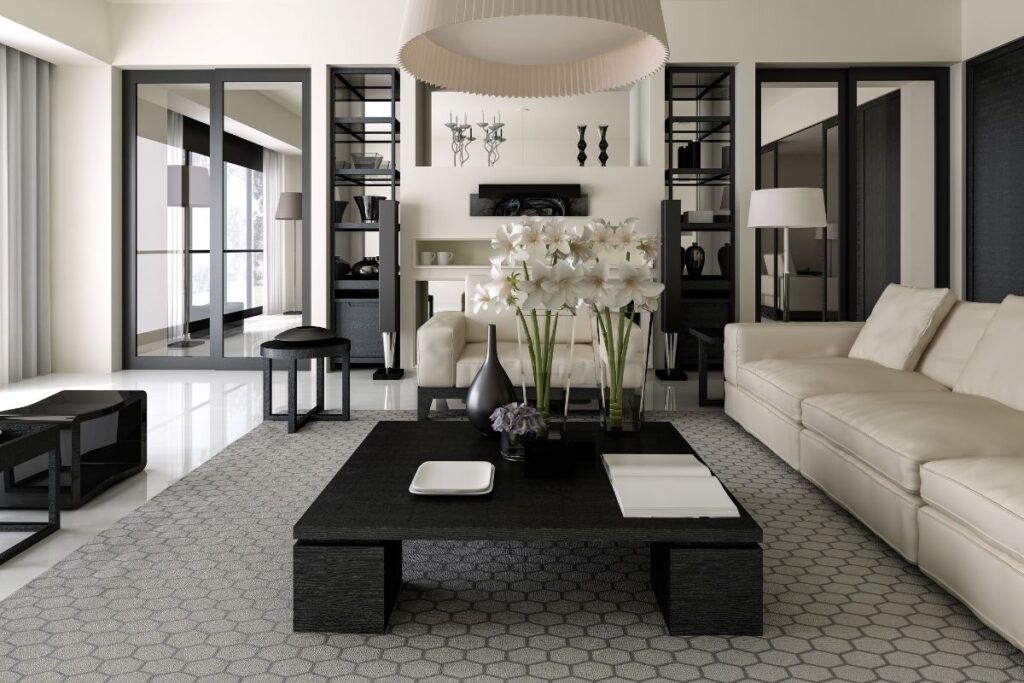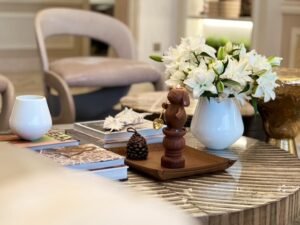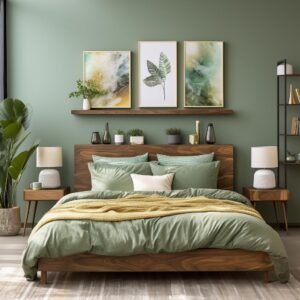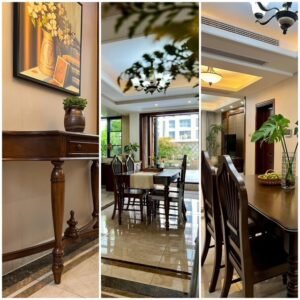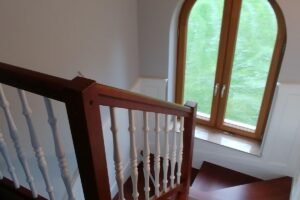Table of Contents
Are you a renter struggling to personalize your living space? The intersection of interior design and home decor offers many possibilities for creating authentic, stylish environments, even in rentals. While interior design enhances a space’s functionality and aesthetic appeal through professional interior design services, home decor focuses on personal expression with elements like colors, furniture, and accessories. Combining these concepts allows renters to overcome lease restrictions and limited customization options. Renters can transform any rental into a cozy and personalized home by utilizing removable decor, versatile furniture, and strategic color schemes. Discover how to blend these two disciplines to create a space that reflects your personality.
Understanding the Essence of Interior Design and Home Decor
Interior design and home decoration are unique but interrelated processes focused on designing a living area. By their very definition, interiors habitually respond to a space, how that space is planned, and how it is lit and furnished. For example, an interior designer might propose an open-space layout to address spatial issues or increase light in a small apartment.
Home decor, on the other hand, deals with the aesthetics and features of the space, the details that make it more unique. It involves the choice of appropriate colors, furnishings, and accessories that match personal preferences. For instance, placing an area rug with a bright color and accent pillows of the same shade can instantly change the look of a dull living room and make it warm and homely. Awareness of these differences can be advantageous for the renters.
From this perspective, it can be understood why this difference can be reasonable for renters. They can follow the interior design mandate while choosing appropriate accessories and furniture, making the home appealing. Yet, one can relocate without having caused a lot of structural changes.
The Challenge of Personalization in Rental Spaces
One of the main challenges that renters experience is making a space there while not owning it. Some leases restrict painting walls, making structural changes, or even hanging art, which confines choices. However, most solutions help renters add personality and comfort to their homes without breaching their tenancy agreements.
Plastic decor elements are helpful. Some options, like peel-and-stick wallpaper, allow for changes while giving a room a new and fresh look without significantly harming the space. Futuristic tiles are often utilized as a temporary floor in the kitchen or bathroom to alter its appearance. Adhesive hooks are well suited for hanging mirrors, paintings, and other objects that sticky adhesive should not damage.
Another essential feature involves the use of multi-functional furniture. For example, a modular sofa can be easily moved to accommodate different space arrangements, while a folding dining table can serve various purposes. That is why we see beds with compartments underneath, which is very helpful when there is little space in the apartment.
Renters can also personalize their space with textiles. Area rugs, curtains, and throw pillows add warmth and style. For instance, a bright rug can define a living area and make it feel cozier. Renters can create a personalized and welcoming home using these strategies without compromising their lease agreements.
The Role of Furniture in Creating Cohesive Spaces
Furnishing is crucial, whether it is interior design or home accessories. Renters’ choices are limited and specific since the furniture has to be practical, especially if the renters have to transport it from one place to another. Medium-density furniture, sofa beds, storage ottomans, and extendable dining tables maximize space and adapt to different living situations. For example, a sofa bed can be a good chaise during the day and a sofa at night, which is a good choice for small apartments.
The process of selecting furniture contributes to integrating a particular living space design. The juxtaposition of the bland exterior with a more contemporary interior design contributes to the film’s aesthetics. Concurrently, an unclear theme of dramatic patterns and various textures adds character to the room. For instance, it is possible to use a beautiful glass dining table and accommodate mid-century modern chairs; it will look unique but not too dramatic.
While choosing furniture, renters need appropriate furniture that depicts their personalities and suits their homes. For example, a customized piece of furniture like a bookshelf can serve the operational purpose of storage and decor at the same time. If renters are savvy and choose multipurpose and elegant furniture, they can design spaces with unity, amiability, and individuality.
The Impact of Color Schemes on Mood and Space Perception
It implies that color is very significant in interior design and home embellishment since it can change the mood or even the outlook of a room. Selecting the proper tones of color for renters can turn an ordinary rental property into a cozy nest. Of course, one cannot paint the walls of their rental, but there are numerous possibilities to bring color into living space.
Fabrics, including curtains, rugs, and throw pillows, can be ideal as they are easy to change and bring color and design to the room. For instance, a colorful geometric carpet in a living room decorated mainly in gray shades will add some liveliness and coziness. Also, installing temporary artwork or other colorful decorative items can make a significant difference without needing to paint. A great painting, sculpture, or nearly any other artwork form can be accented and serve as the room’s centerpiece.
It will also be valuable insight for people renting a house to know the psychological impacts of various colors when designing a home that looks and feels good. For instance, blue colors provide a soothing environment and are best suited for bedrooms, and yellow colors provide warmth and would suit areas such as living rooms or kitchens. By strategically using color through various elements, renters can effectively influence the mood and perception of their space, making it feel more like home.
Maximizing Natural Light and Artificial Lighting
Lighting is one of the key elements in interior design and the general concept of home decoration. That is why natural lighting is so important, as it can make the area more meaningful, spacious, and warm. To enhance natural light, renters can use sheer materials as curtains that let in light while ensuring that privacy is achieved. The placement of mirrors opposite other windows will also assist in reflecting light and the perception of a larger space. For instance, if one decides to hang a huge mirror in a tiny living room, the light in the room will effectively be doubled, making the space look more spacious.
Artificial lighting also plays a similar role in defining a functional and comfortable atmosphere. Multiple forms of lighting, including general, focused, and decorative, can be used to create proper lighting in a room. Amber lighting illuminates general working spaces, while particular lighting addresses specific activities, enhancing other lighting to highlight particular areas or items.
Using floor lamps, table lamps, and string lights is one way of introducing texture and personality into the room without altering the lights. For instance, the floor lamp with a reading armchair will ensure adequate task lighting, while the string lights by the bookcase will set the mood. Replacing traditional light bulbs with those that allow for brightness regulation or installing warm light sources also helps create an appropriate environment—natural and artificial lighting helps renters achieve comfortable and versatile lighting on the premises according to their desires.
Incorporating Personal Style through Accessories
Decoration refers to the final touches added to enhance a room. Renters can express their personalities without permanently changing the rentals they occupy. Table accessories such as decorative cushions, blankets, paintings, and pots with green plants bring color, warmth, and emotional notes and are unique.
Diverse care should be taken to ensure that the accessories chosen are of scale, proportional to the size of the furniture, and harmonized to prevent clutter. It is because a few selected items, such as a sizeable eye-catching vase on the coffee table, will have a much more significant effect on the room’s appearance than hundreds of tiny, insignificant trinkets that must be neatly arranged. Other functional accessories, which are portable or easily obtained and altered, like a plain-colored throw that can blend well with any color scheme or setting, may also assist renters in modifying and improving their interiors to suit variant settings and preferences.
Such items as family photos or souvenirs bring the feeling of their own house into a rented apartment or house. These beautiful and functional storage solutions, like baskets and boxes, serve the purpose of storage and add to the room’s appearance. For instance, a stand-alone basket stores blankets and decorates the living room. By thoughtfully selecting and positioning accessories, renters can craft a stylish, functional space that reflects their style and preferences.
The Significance of Functional Layouts
Organizational layout is crucial in creating a high-efficiency living environment. Tenants are always searching for the best way to utilize the limited square footage and meet their lifestyle demands. The mode of movement within a given area and the placement of furniture can make a difference in the look of the place and its usability.
Separating specific zones for certain purposes allows for better organization, such as having a dedicated dining area, a working area, and a rest area. Therefore, the color of rugs, lighting, and the position of furniture could help define these areas and make a small area appear more orderly and larger. For instance, if someone puts a rug under the dining table, this can give the illusion of the dining area being a different space from the living room.
Purchases of shelves, boxes that can be stored under the bed, ottomans that double as storage, etc., help greatly minimize clutter. Kitchen shelving may be used as storage solutions and partition space. Under-bed storage bins will help store clothes and other fabrics, like towels and blankets, which are not required daily.
Flexible furnishings also offer another way to make an accommodation more versatile. The furnisher should organize furniture so the renter can easily change their arrangement to adapt to various functions or people. It indicates that through the functional arrangement of the space, renters can create a functional and attractive environment with which they can be satisfied.
Style Clan: The Art of Mixing and Matching Styles
Intersecting various design styles provides the individual with a fascinating opportunity to shape a stimulating living space. Combining modern, retro, industrial, and boho-style features creates a unique and comfortable tenant environment.
This approach’s strength is finding one element that will allow a variety of styles to work together effectively. Unifying various objects through consistent and related colors, textures, or production materials is possible. For instance, a minimalistic metallic gray sofa and an aged wooden coffee table can complement each other if the shades of wood are either the same or similar.
Individuals should begin with large furniture items to create this approach, which may be a foundation for introducing more robust motifs in accessories or other home decorations. It is essential to apply and try various aspects, like combining and overdressing, while simultaneously ensuring that all the arranged pieces harmoniously blend. Focusing on such possibilities also helps to enrich interior designs with artistic elements and turn every rental into a home.
Budget-Friendly Tips for Renters
Creating an authentic and stylish living space doesn’t have to be expensive. Renters on a budget can achieve a high-end look without breaking the bank by exploring thrift stores, flea markets, and online marketplaces. These places often have unique and affordable furniture and decor items that add character to a home. For example, finding a vintage mirror at a flea market can serve as a statement piece in any room.
DIY projects offer another cost-effective way to personalize a space. Painting furniture, creating artwork, or sewing curtains and pillows can add a personal touch while saving money. For instance, repainting an old dresser in a bold color can transform it into a focal point in the bedroom.
Focusing on a few key pieces can also elevate the overall aesthetic. A statement rug or a stylish sofa can significantly impact the look and feel of a room without requiring a complete overhaul. Investing in versatile and timeless items ensures they can be used in various settings and styles.
Swapping out small details, such as cabinet handles or light fixtures, can make a big difference. These simple updates can modernize a space without significant expense. By combining these strategies, renters can create a chic, personalized living environment that reflects their style and budget constraints.
Maintaining Flexibility and Adaptability
Flexibility and adaptability are crucial for renters, who may frequently move or face changing living arrangements. Selecting decor and design elements that can easily transition between different spaces is essential for maintaining a sense of home, regardless of the location.
Portable and modular furniture offers practical solutions, allowing for easy reconfiguration to suit various spaces and needs. For example, modular shelving units fit different layouts and can serve as bookshelves or room dividers, depending on the space’s requirements. Similarly, removable decor elements like peel-and-stick wallpaper and adhesive hooks enable personalization without permanent alterations.
Choosing accessories that complement any decor style, such as neutral-colored throw blankets and multipurpose storage baskets, ensures these items remain helpful and visually appealing in various settings. Lightweight furniture pieces that are easy to transport also reduce the hassle of moving, making transitions smoother.
By prioritizing items that enhance a space’s functionality and aesthetics while accommodating changes, renters can ensure their homes remain stylish and comfortable and adapt seamlessly to the future.
The Future of Interior Design and Home Decor for Renters
With the development of the rental sector, the use of interior design and home decor for renters is rapidly gaining importance. Some trends predicted to define this industry include improvements in removable and flexible wall decorations like peel-and-stick wallpapers and modular furniture. Also, the importance of cost-effective design is rising, especially with the incorporation of recyclable and efficient energy materials used in construction.
Residents can, therefore, look forward to the trends and try the best ways to improve the interiors of their rented houses. For instance, technology such as apps for controlling lights and Thermostats in smart homes appeal to renters because they get to change the environment around them without permanent fixtures. As the concept of rental homes is expected to evolve, flexibility and creativity will be vital in developing genuine and purposeful spaces. By adopting these changes, renters can make their homes relevant, aesthetic, and valuable to suit their personalities and needs at any time.
Conclusion
By adhering to the above recommendations and making interior design and home decoration work hand in hand, renters can make their rented spaces as unique as possible. Be more flexible, choose multipurpose furniture and ornaments, and experiment with their placement. Get started to change your rental now! Create your home to be a fashionable, comfortable retreat showcasing who you are. Do not hesitate—build the house of your dreams today!

